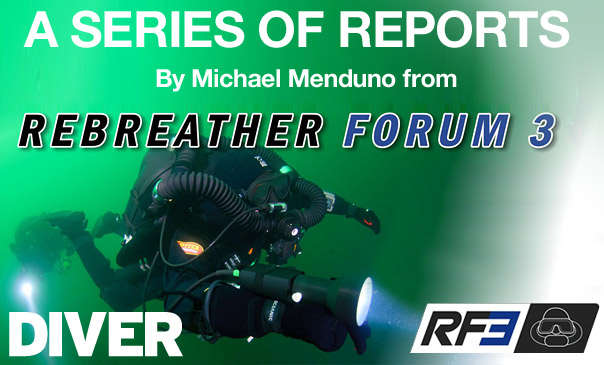Engineering The CCR Blues Away
Fourth in series of reports on Rebreather Forum 3 by Michael Menduno.
In addition to training and creating a culture that reinforces safe rebreather diving practices, experts agree that a number of safety issues might be resolved through better engineering of the equipment itself. Indeed, this is the thinking behind PADI’s so-called “Type R” rebreathers that are suitable for recreational divers. For example, a Type R rebreather will turn on automatically if the user forgets before jumping in the water, and it won’t operate without the scrubber canister correctly in place or if the cylinders are turned off.
What became very clear at the Rebreather Forum is that better engineering solutions are needed for one of most fundamental aspects of rebreathers: knowing precisely the composition of the breathing gas in the loop at any point in the dive. Unlike open circuit where the fraction of gas is constant and known with certainty, the gas mix in a rebreather diver’s breathing loop changes dynamically with every breath and gas addition.
Ten or 15 years from now we’ll likely look back at today’s technology as primitive, or what explorer and engineer Dr. Bill Stone, CEO of Stone Aerospace, refers to as “test pilot era” technology. “You actually dived those units without knowing exactly what you were breathing? OMG!” It’ll be like us looking back at early cave divers using the old J-valve gas reserve technology and empty Clorox bottles for buoyancy, and saying, ‘Really’”?
Bruce Partridge, CEO of Shearwater Electronics, in his presentation on information systems, summed up the current state of the art this way, “Divers must interpret the readouts from three roaming O2 sensors, which are known to be unreliable. They dive with no CO2 gauge and they don’t have good data on the risks, or what is most likely to go wrong.”
The Trouble With O2 sensors
Most experts agree that current O2 sensing systems are the weakest links on a rebreather, and also the most critical. If the PO2 in the loop is too low, the diver will suffer hypoxia, fall unconscious and drown; too high and the diver risks hyperoxia, convulsions and drowning.
But what most divers might not appreciate are the limitations of current O2 sensing systems on the market, made clear in a pair of presentations by biomedical instrumentation engineer Dr. Arne Sieber, CEO of Seabear Diving Technology, who built his own rebreather, and Nigel Jones, principal at RMB Consulting, who works with Stone Aerospace.
Sieber began by explaining that the galvanic O2 sensors, made for the biomedical industry were never designed to be used in diving and in that application they are, in fact, being used outside the manufacturer’s specifications. Specifically, he said, the sensors should be calibrated under the same conditions they’ll be used for measurement, in the same measurement range and temperature. That’s not how it’s done in diving.
“Divers do all the wrong things,” explained Sieber. “We calibrate the sensors at 0.2 bar (air) and 1.0 bar (O2) at ambient pressure and temperature, and then use the sensors at up to 1.6 bar at much hotter temperatures.” He said this leads to increased sensor error, and a decreased lifespan.
Sensors can fail high or low as a result of the gradual consumption of their reactive material, aging, and they can also fall out of calibration. In addition they commonly fail from condensation on the sensor. Worse is that “transient failures” from a loose electrical connection or, more commonly, condensation, causes the sensor to generate erroneous data, and then go back to working correctly when the condition abates. Jones believes that these “transient failures” are insidious and likely the cause or trigger of many unexplained rebreather diver fatalities.
Because these sensors are known to be unreliable, early designers in the late 60s, took precautions. For instance, the inventor of the “Electrolung,” Walter Stark, built the first closed circuit rebreathers with three O2 sensors and a voting logic algorithm. The computer averaged the readings from the two sensors whose readings were closest and used that average for its O2 calculations. The idea was that the redundancy of three voting sensors would greatly reduce the risk of sensor failure… and the concept stuck. Today, virtually all rebreathers except the Poseidon use this 50-year old sensing technology. The problem, Jones told the Forum, is that the system is simply not as reliable as once thought.
Using probability theory he showed in the first place that the voting logic algorithm itself actually reduces the benefits of redundancy. For example, instead of having a system that is “hundreds” of times more reliable (such as with pure triple redundancy), a voting logic system can reduce the improvement to single digits.
Second, he said, voting logic is based on the assumption that sensors fail independently, in other words the failure of one sensor does not change the likelihood that others will fail too. Unfortunately that is NOT the case with the O2 sensors in a rebreather. The sensors are dependent because they share a common history; they may have come from the same manufacturing lot of a company, they experience similar use, they share a common environment, suffer common abuse and use shared measurement and calibration gas. The lack of independence greatly decreases reliability. “Having three sensors is barely better than one in some circumstances,” Jones emphasized.
Thirdly, risk reduction is eroded further by the fact that there are more than two outcomes to the system: heads, a correct reading or tails, an incorrect reading. The third outcome is when the diver doesn’t know if the reading is correct or incorrect, which Jones equated to having the coin land on its edge.
He offered a real-world dive scenario reported by Rich Pyle, in which his PO2 sensors read 0.4, 1.0 and 1.3. He asked the audience to make the call, “what is the correct PO2?” (The computer’s voting logic would average the 1.0 and 1.3 reading and call it 1.15). Unfortunately, the majority of the audience got it wrong! The correct answer was 0.4; the system had experienced a double sensor failure. Fortunately, Pyle got it right. If he had ascended at that point in the dive thinking his PO2 was 1.15, he would have risked hypoxia and possible drowning.
An animated discussion ensued. Leon Scamahorn, CEO of Inner Space Systems, maker of the Megalodon rebreather, said users of the “Meg” could go the “millivolt screen” on their handset, which shows actual sensor voltage (a linear function of PO2) and with some simple math determine that the low sensor was correct. Of course, this assumes the diver was alerted to the problem in time. Scamahorn’s arguments did not address the limitations of voting logic systems.
With thousands of hours diving his rebreather, I’m sure Pyle wouldn’t have a problem with Scamahorn’s procedure – he was tipped off to his faulty sensors by the lack of voltage fluctuations – but I couldn’t help but wonder if I’d have the calm presence of mind to do “millivolt math” at 330 feet (100m) with the stress of a possible alarm and knowing one or more of my sensors were crapping out. Definitely a test pilot-esque notion! Couldn’t a computer do this better than me?
Both Sieber and Jones urged the industry to develop and adopt “active validation” type systems, such as used in the Poseidon MK-VI, which calibrates and tests the validity of the oxygen sensors (the MK-VI uses two sensors) throughout the dive using onboard diluent and oxygen. Sieber added that solid-state sensors, which are currently in prototype form, also hold promise for the future.
However, several rebreather manufacturers I spoke with disagree with the assessment offered by Sieber and Jones, saying they overstated the O2 sensing problem, given improvements in sensor manufacturing, testing, and voting logic software. As one manufacturer said, “there’s more than one way to skin the cat.”
Nevertheless, in its consensus recommendations (see separate story), the Forum strongly endorsed industry initiatives to improve oxygen measurement technologies and advocated consideration for new approaches like “active validation” and alternatives to galvanic fuel cells.
 Writer and technologist Michael Menduno published and edited aquaCorps: The Journal for Technical Diving (1990-1996), which helped usher tech diving into the mainstream of sports diving, and coined the term “technical diving.” He also organized the first Tek, EuroTek and AsiaTek conferences, and Rebreather Forums 1.0 and 2.0. Menduno, who is based in Berkeley, CA remains an avid diver.
Writer and technologist Michael Menduno published and edited aquaCorps: The Journal for Technical Diving (1990-1996), which helped usher tech diving into the mainstream of sports diving, and coined the term “technical diving.” He also organized the first Tek, EuroTek and AsiaTek conferences, and Rebreather Forums 1.0 and 2.0. Menduno, who is based in Berkeley, CA remains an avid diver.
More from the forum:
Part 1
Part 2
Part 3
Part 5
Part 6








